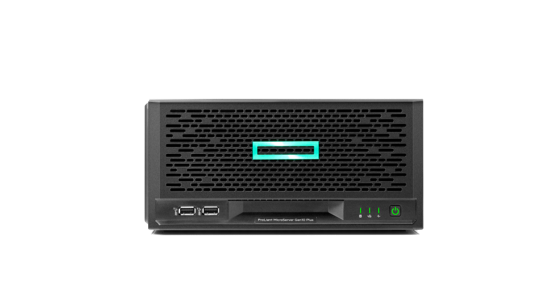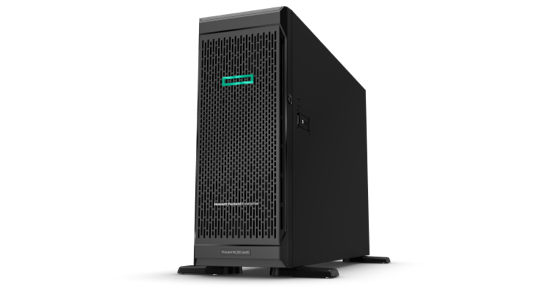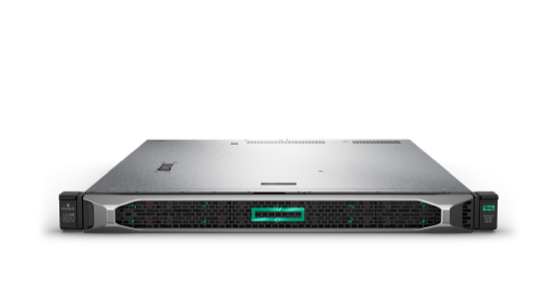
HPE ProLiant MicroServer
A compact solution just right for small businesses

We know that selling hardware in the cloud-focused world isn’t always easy, so we’ve created this guide to help you have more successful customer conversations.
In the year ahead, your customers’ success will depend on technology that helps them be hyper-connected and data-driven. Challenges like budget constraints, small IT teams, and a fast-evolving business landscape make it tough for SMBs to implement the right technology—but that’s where you come in.
By offering HPE ProLiant servers with SYNNEX, you can give customers the hybrid cloud solution they need to grow and compete, while you build a more profitable business.

Because a hybrid solution can help mitigate their biggest challenges. HPE ProLiant servers provide a foundation for a hybrid cloud approach, allowing SMBs to keep their most sensitive data on-premises while moving other workloads into the cloud. The right servers help customers overcome common issues like security concerns, overly complex infrastructures, underused resources, and a lack of in-house expertise.

There’s never been a better time. More than ever, SMBs need tools to help them be agile and resilient. SMBs should plan their technology investments 5–7 years ahead, and a hybrid cloud approach that includes servers like HPE ProLiant provides the flexibility they need to grow and address new challenges.


Yes, if you align technology to business needs. SMBs are spending cautiously in 2021, so buy-in from finance and leadership is key. Share how HPE ProLiant can help support initiatives like reduced costs, increased revenue, and improved efficiency.

Today’s best servers give SMBs a strategic foundation for growth. Solutions like HPE ProLiant simplify infrastructure with artificial intelligence, provide holistic security, enable remote work with Virtual Desktop, easily automate tasks, and maximize data’s usefulness.



Absolutely. Cloud-ready solutions help SMBs deploy applications quickly, reduce costs, and scale capacity as business needs change. In fact, HPE ProLiant Gen10 servers offer a complete foundation for hybrid cloud, enabling 50% faster server migrations,1 33% quicker installs,2 and improved app performance with 82% greater memory bandwidth.3
1TechValidate. Small Business Computer Services Company: HPE ProLiant Server Solutions Case Study. 2021.
2, 3HPE Internal Research.
Whatever the size of your business and however you want to grow, the HPE ProLiant family of servers provides a flexible, hybrid cloud-ready, and powerful infrastructure that flexes with your needs.

A compact solution just right for small businesses

Self-contained towers ideal for remote or brand offices and growing businesses

Secure, versatile rack-mounted servers for multi-application workloads
From navigating the onboarding process to maximizing the benefits of the HPE Partner Program, SYNNEX is here to help you build a thriving HPE practice.
It depends on your customer’s unique situation and goals. For businesses that lack office space or that haven’t already invested in servers or data centers, the cloud can offer affordable operations without sacrificing privacy or security.
However, despite these benefits, some businesses face limits to what they can achieve in the cloud. Cloud costs grow as team size and data increase, and eventually those costs may become untenable for a small business.
But those concerns don’t mean businesses must move fully into the cloud to take advantage of its benefits. More businesses are opting for hybrid IT strategies because they get the best of both worlds: the agility of the cloud combined with the security of on-premises servers. In fact, according to IDG’s 2020 Cloud Computing Study, 92% of organizations have an IT environment that is at least somewhat in the cloud today, while only 8% say their total IT environment is on-premises only.
Ultimately, a hybrid cloud approach helps SMBs structure their IT environment more practically than simply going all-in with the cloud. For example, SMBs can keep their most crucial applications in-house—including those subject to compliance regulations—and move other workloads like payroll or office applications into the cloud. With the right balance between on-premises servers and cloud computing, SMBs are poised to reduce administrative burden and cost while optimizing operations.
There are a lot of signs that a business is ready for the next step in growing their IT infrastructure. If they’re planning ahead and looking for ways to enhance security, reduce costs, optimize workloads, implement intelligent automation, or want to improve agility, or accommodate a remote workforce, an HPE server upgrade could be the right solution.
But there are other indicators a business is ready for new servers. If your customer’s team has grown, it might seem like implementing a cloud server is the right idea—but cloud costs can increase as team size and data amount increase. Implementing a hybrid IT infrastructure with HPE ProLiant servers can help customers scale the way they want to, likely at a lower cost than a cloud solution.
You can get even more details about investment in our SMB Tech Investment Guide.
Research indicates that SMBs do benefit more from hybrid IT infrastructures than their enterprise counterparts. A study from Aberdeen Research found that with a hybrid infrastructure, 78% of SMBs gain improved IT flexibility compared with only 36% of all others, and 79% are able to reduce risk, compared with 47% of all others.
It’s never a good idea to put off upgrading the technology a business needs to operate securely. Legacy technology simply cannot protect businesses the way modern servers do.
Outdated IT leaves SMBs vulnerable to significant security threats like data breaches, malware, ransomware attacks, and data theft. Data breaches cost small businesses $149,000 on average, a price most can’t afford. What’s more, more than half of small businesses shutter their doors within six months of experiencing a data breach.
If they don’t upgrade, SMBs also miss out on support for end-of-service operating systems like Windows Server 2008 and SQL Server 2008, which both retired in January 2020. If your customers haven’t upgraded by now, they might be stuck paying high fees or making several-year commitments in exchange for support, all for outdated software.
2020 has seen an increase in security problems, too. Forbes reported a 238% increase in attacks on banks, and a 600% increase in attacks on cloud servers, just between January and April 2020. Remote work has further complicated things: a survey from Malwarebytes reported that 20% of cybersecurity leaders say they have faced a security breach because of a remote worker in 2020. If ever there were a time to bolster security, it’s now.
Check out our infographic for more details about helping customers future-proof their businesses with HPE ProLiant.
AI and edge computing
More business and IT leaders are ready to embrace advanced technology. While only 3% of SMBs currently say that AI factors into their technology plans for the next 12 months, Aberdeen Research predicted that percentage would jump to 16% in 2020, while augmented reality (AR) would increase from 16% to 31%.
Desktop Virtualization
HPE offers a portfolio of virtual desktop solutions that help SMBs be agile, productive, and secure from anywhere. Read our brief to learn more.
Security
HPE ProLiant Gen10 server solutions ensure a comprehensive, 360-degree view of security. In fact, HPE has created the Silicon Root of Trust to ensure the Gen10 servers offer unique, powerful security features all the way down to the silicon. Learn more about how HPE ProLiant Gen10 servers can help protect your critical apps and data.
vSAN (virtual storage area network)
HPE vSAN ReadyNodes set aside traditional, manually driven processes and technologies, shifting instead to an automated, secure approach. HPE vSAN ReadyNodes extend optimization beyond workloads to include a tightly coupled integration of physical and virtual management. Read the brief for more details about how this solution provides a fast path to optimized workloads.
Containerization
Containerization technology helps organizations build high-quality applications faster and at a lower cost. The Red Hat OpenShift Container Platform solution, based on HPE ProLiant DL servers, offers SMBs an end-to-end, integrated container platform that can be easily configured and quickly deployed. Download our guide to learn more about Red Hat OpenShift.
By offering HPE ProLiant with SYNNEX, you’ll give customers the latest innovations in security, automation, and hybrid cloud to drive their success in an always-shifting business landscape. Your customers will get everything they need to future-proof their business—and you’ll get a partner to help expand your own.
By partnering with SYNNEX, you’ll have access to dedicated resources—like personalized support and an ecosystem of vendor solutions—that empower your business before, during, and after each sale. You’ll also get access to the most profitable partner program in the industry so you can drive even more recurring revenue.
To learn more about how SYNNEX can help you craft a thriving HPE practice, download the reseller guide or visit the resource hub.
Want to know more about something we haven’t covered on this page? You might find what you’re looking for in the Why SYNNEX for HPE Guide.
But if you still have questions or you’d just like to connect with our team, please don’t hesitate to contact us .
Want to know more about something we haven’t covered on this page? You might find what you’re looking for in the Why SYNNEX for HPE Guide.
But if you still have questions or you’d just like to connect with our team, please don’t hesitate to contact us.